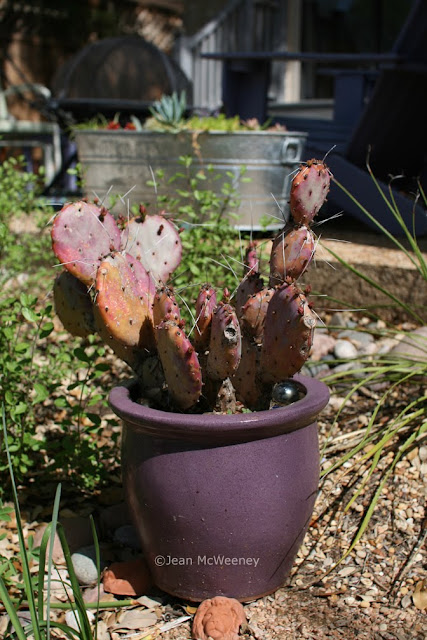Redbud blooms (Cercis (canadensis?))
Just when I think I'm okay with my new life and my not-so-new-anymore town, I go to Austin. Ah Austin, my old hometown. Austin likes to celebrate itself and nothing epitomizes that more than a beautiful weekend in the spring - everyone is smiling, the wildflowers and trees are blooming, the sun is shining, the air is at just the right temperature, and absolutely everyone is outdoors.
Spineless Prickly Pear
Between many visits with old friends I managed to find my way to Zilker Botanical Garden. It's an old garden that meanders through diverse habitats and it was a perfect way for me to enjoy some sun without spending money (at the nurseries, of course!).
Lorapetalum tree
Have you ever seen a lorapetalum in tree form? I found this one at the entrance to the garden. Amazing.
"Mother" tree (pittosporum) and waterfall
Teahouse view
Zilker Botanical Garden Teahouse
Texas Mountain Laurel
Rainwater collectors
Pam, owner of Penick Landscape Design and writer of the blog Digging, is an amazing garden designer and my photos really can't do her yard justice. She has a gardener's garden - it's perfect for strolling through, examining close up the many Texas natives as well as succulents, cacti, and other well adapted plants.
Santa Rita Opuntia (Pam, correct me if I'm wrong!)
Above you can see Pam's second patio overlooking the stock tank pond. The blue water of the pool is so cool and calming. This photo was taken on a natural pathway made of giant limestone boulders. I mean giant - they are there naturally and Pam has made the most of them.
I can't believe I didn't get a good photo of Pam's stock tank pond and the new rock spiraling around it. It's fabulous. I think we were just too busy talking for me to capture those good photo ops so you'll just have to visit her blog. Click on this link to see one of her latest posts that includes a photo of it.
Agave ovatifolia
I did manage to get a photo of her iconic Whale's Tongue agave. It's even more impressive in person and looks incredibly happy there. Thank you Pam, for taking time out of your day to show me around and gab about the gardening life. I only wish I had had more time and could have joined you and other Austin bloggers at Design-a-go-go.
I leave you with a typical Texas spring scene of wildflowers and blue sky. I'll see more of this on my next trip, this time to Houston (and yes, more garden related adventures are on tap!).
This post was written by Jean McWeeney for my blog Dig, Grow, Compost, Blog. Copyright 2009. Please contact me for permission to copy, reproduce, scrape, etc.

















































